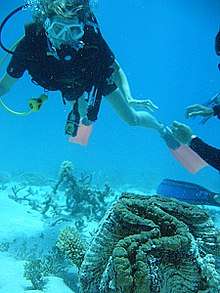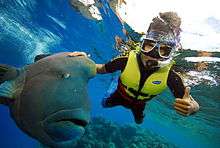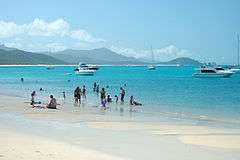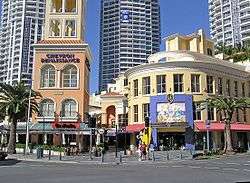Tourism on the Great Barrier Reef

Tourism is one of the major industries in the Great Barrier Reef region. Approximately two million people visit the Great Barrier Reef each year.[1] According to the WWF, tourism of the area contributes $5.4 billion a year to the Australian economy, and employs approximately 69,000 people.[2] Ove Hoegh-Guldberg sees the key competitive advantage of the Great Barrier Reef as opposed to other, closer, reef tourism destinations is the region's reputation as being "the most pristine coral reef on the planet".[3] The GBRMPA states that careful management, which includes permits for camping and all commercial marine tourism within the Great Barrier Reef Marine Park, has so far ensured that tourists have a very minimal impact on the reef.[4]
History
.jpg)
The earliest known tourism in the region took place on Green Island in the 1890s.[6] In the early 20th century, scientific field expeditions became popular in the region, which laid the groundwork for tourism. Another tourist activity that was briefly popular was visiting Aboriginal missions, but this was clamped down upon by the missionaries who disapproved of the tourists giving money and goods to the Aboriginals. Torres Strait Islanders relocated south to the Whitsundays to demonstrate turtle hunting and performed songs and dances for tourists.[7] In 1931, The Morning Bulletin called for increased awareness of tourism in the area, extolling the game fish that could be caught in the region.[8] Tourism largely stopped during World War II.[7]
During the 1960s and 1970s, tourist numbers grew steadily, and transport improved and boats that extended day trips to between 15 and 20 nautical miles were invented.[6] The remoteness of several parts of the Great Barrier Reef had naturally prevented access and therefore human impacts.[9]
In 1981, the Great Barrier Reef was inscribed on the world heritage list.[10] Tourism is regarded to be an important way that Australia can fulfill its duty to present the Great Barrier Reef in accordance with the world heritage convention.[6] In the 1980s, tourism in the Great Barrier Reef region expanded rapidly.[11] At one point during the 1980s, a floating hotel operated.[12] As of 1987, 450,000 tourists visited. Skeat and Skeat attribute the growth in tourist numbers during the 1980s to improved air access to regional areas, including the Cairns International Airport, and large catamarans which allowed day trips of 50 nautical miles.[13] During the 1980s, there was concern that tourism was harming the reef.[14] The disappearance of Tom and Eileen Lonergan in 1998 while scuba diving off the Great Barrier Reef caused the Queensland government to commission a task force to review the workplace health and safety standards of recreational diving and snorkelling.[15]
Tourism briefly dipped in 2006 due to competing overseas events such as the FIFA World Cup.[16] The 2008 financial crisis saw a reduction in both international travellers and business travellers, with the later group declining by 9% in 2009 compared to the previous year.[17] After the 2010–2011 Queensland floods many travellers cancelled trips to the state, resulting in a loss of hundreds of millions of dollars.[18]
The Reserve Bank deputy governor Philip Lowe stated in February 2012 that tourism in Australia is having undergo structural changes because of a contraction in the sector due to the impact of a high Australian dollar.[19] By 2012, the estimated value of tourism in the Great Barrier Reef region had reached $5.5 billion.[20] In the wake of Cyclone Marcia, a marketing campaign urged people to visit the region to help it recover.[21] In response to the coral bleaching event of 2016, where only 7% of the reef was unaffected, the tourism industry created a hashtag, #GBRtoday showing healthy corals.[22] Also in 2016, the Australian government asked for a chapter on climate change and the Great Barrier Reef to be removed from UNESCO's report on the status of the Great Barrier Reef over concerns it could impact on tourism.[23][24] Domestic tourism to the reef subsequently fell.[25]
Locations
As of 2003, 85% of tourism in the region was concentrated in Cairns and the Whitsunday areas of the Marine Park.[12]
Vessel-based tourism operations
Vessel-based tourism operations can serve from 10 to over 400 people. Extended vessel-based tourism operations can last for weeks and move between different sites.[12]
Safety
The disappearance of Tom and Eileen Lonergan in 1998 while scuba diving off the Great Barrier Reef caused the Queensland government to commission a task force to review the workplace health and safety standards of recreational diving and snorkelling.[15] In 2003, Gabe Watson and his wife Tina were dive buddies on an expedition, despite Tina's inexperience. Tina drowned and Watson was subsequently convicted of manslaughter.[26] In 2008, another two tourists were left behind, and had to tread water for 19 hours.[27] In 2011, another tourist was left snorkelling and had to swim to another boat.[28]
Types of tourists
A survey conducted in 2003 found that visitors to the Whitsundays were likely to be first-time visitors to the Great Barrier Reef, had an average age of 37, were mainly international visitors, were likely to be visiting with a partner or their family, and were likely to have taken part in snorkelling, swimming, or taking part on a semi-submersible tour.[29]
A report in 1995 found that tourists expected to see beautiful islands and beaches, to experience a "natural, unspoilt environment", and to see a variety of fish and corals, and compare their experience with idealised tourist advertising.[30]
A report in 1999 found that older tourists participated in fewer activities at the Great Barrier Reef, and urged caution in considering them a lucrative market.[31]
A 2003 paper discussed the patterns of repeat visitors to the GBR region. It found that they were younger, likely to be backpackers or interstate tourists, if they were international visitors they were likely to be from North America or Europe, more likely to go diving and to want to go diving, and more likely to seek smaller, specialised operations for their return visit.[11]
A survey in 2015 found that two thirds of tourists wanted to see the Great Barrier Reef before it was gone.[32]
Management and regulations
The Great Barrier Reef Marine Park Act 1975 is one of the major laws governing the management of the Great Barrier Reef Marine Park.[33] When it was passed, the management of tourism was seen as an important issue.[34] Ros Kelly proposed a 1% tax on tourism activities in the GBR in 1991, but this was criticised by Queensland's premier, Wayne Goss.[35] All licensed tourism operations in the Marine Park must pay the Environmental Management Charge (EMC),[36] introduced in 1993,[14] which provided 18% of the Great Barrier Reef Marine Park Authority's budget in 2009–2010.[37]



See also
References
- ↑ Great Barrier Reef Marine Park Authority. "Number of Tourists Visiting The Great Barrier Reef Marine Park". Retrieved 19 October 2011.
- ↑ "The Great Barrier Reef". World Wide Fund for Nature.
- ↑ Hutchings, Pat; Kingsford, Mike; Hoegh-Guldberg, Ove (2008). The Great Barrier Reef: Biology, Environment and Management. CSIRO Publishing. p. 106. ISBN 978-0-643-09557-1.
- ↑ "Outlook for the reef: Commercial tourism". Great Barrier Reef Marine Park Authority. Retrieved 9 November 2011.
- ↑ "The sport of turtle riding and 'the Greatest Liar on Earth'". Australian National Maritime Museum.
- 1 2 3 "1301.0 - Year Book Australia, 2003". Australian Bureau of Statistics.
- 1 2 Pocock, Celmara (30 July 2014). "Aborigines, Islanders and Hula Girls in Great Barrier Reef Tourism". The Journal of Pacific History. 49 (2): 170–192. doi:10.1080/00223344.2014.897201.
- ↑ "THE GREAT BARRIER REEF". The Morning Bulletin. Rockhampton, Qld. 19 March 1931. p. 6. Retrieved 22 December 2015 – via National Library of Australia.
- ↑ "7. Pressures on the Marine Park" (PDF). Archived from the original (PDF) on 30 July 2008.
- ↑ UNESCO World Heritage Centre. "Great Barrier Reef".
- 1 2 Moscardo G, Saltzer R, Galletly A, Burke A, Hildebrandt A. 2003. Changing Patterns of Reef Tourism. CRC Reef Research Centre Technical Report No. 49, CRC Reef Research Centre, Townsville. https://web.archive.org/web/*/http://www.reef.crc.org.au/publications/techreport/pdf/Technical%20Report%2049.pdf
- 1 2 3 "Marine Tourism on the Great Barrier Reef: Current state of knowledge 2003" (PDF). CRC Reef Research Centre. 2003. Archive index at the Wayback Machine.
- ↑ Skeat, Andrew; Skeat, Hilary (2007). "Tourism on the Great Barrier Reef: A Partnership Approach". In Bushell, Robyn. Tourism and protected areas benefits beyond boundaries : the Vth IUCN World Parks Congress. Wallingford, UK: CABI Pub. p. 318. ISBN 9781845931766.
- 1 2 Harriott, VJ. 2002. Marine tourism impacts and their management on the Great Barrier Reef. CRC Reef Research Centre Technical Report No 46. CRC Reef Research Centre, Townsville. https://web.archive.org/web/*/http://www.dfg.ca.gov/mlpa/pdfs/comments/kfc_072905b.pdf
- 1 2 Wilks, J. (2006). "Scuba Diving and Snorkeling Safety on Australia's Great Barrier Reef". Journal of Travel Medicine. 7 (5): 283–9. doi:10.2310/7060.2000.00078. PMID 11231213.
- ↑ Annual Queensland Economic Report
- ↑ Courtney Trenwith (19 April 2010). "Queensland economy slumps to seventh". Brisbane Times. Fairfax Media. Retrieved 17 February 2012.
- ↑ Amy Pyett & Michael Smith (12 January 2011). "Queensland tourism sector faces flood, image damage". Reuters. Retrieved 17 February 2012.
- ↑ "Dollar, mining boom spark economic shake-out". ABC Melbourne. Australian Broadcasting Corporation. 16 February 2012. Retrieved 17 February 2012.
- ↑ Patrick Caruana (8 July 2012). "Time to 'step up' on Reef protection". Brisbane Times. Archived from the original on 10 July 2012. Retrieved 22 July 2012.
- ↑ "Tourism campaign to encourage Queenslanders to visit Southern Great Barrier Reef – Queensland Tourism Industry Council". Qtic.com.au. 2015-03-03. Retrieved 2017-10-22.
- ↑ Jon C. Day (2016-04-26). "Great Barrier Reef bleaching stats are bad enough without media misreporting". Theconversation.com. Retrieved 2017-10-22.
- ↑ Markham, Adam (27 May 2016). "Revealed: report for Unesco on the Great Barrier Reef that Australia didn't want world to see". The Guardian. Retrieved 30 October 2017.
- ↑ Anderson, Allison (27 May 2016). "Climate change, tourism and the Great Barrier Reef: what we know". The Conversation. Retrieved 30 October 2017.
- ↑ Smee, Ben (7 June 2018). "Domestic tourism to Great Barrier Reef falls in wake of coral bleaching". Guardian Australia. Retrieved 18 June 2018.
- ↑ Toni O'Loughlin. "Husband admits killing wife in scuba death on Great Barrier Reef". the Guardian.
- ↑ Barbara McMahon. "As sharks prowled, forgotten divers waited ... and waited". the Guardian.
- ↑ "Australian officials investigate after US snorkeller left behind in sea". the Guardian.
- ↑ "Wayback Machine" (PDF). Web.archive.org. Archived from the original (PDF) on 2014-03-04. Retrieved 2017-10-22.
- ↑ Fenton, D. M.; Young, M.; Johnson, V. Y. (1998). "Re‐presenting the great barrier reef to tourists: Implications for tourist experience and evaluation of coral reef environments". Leisure Sciences. 20 (3): 177–192. doi:10.1080/01490409809512279.
- ↑ CAB International. "Cookies Required – CAB Direct".
- ↑ Piggott-McKellar, Annah. "Survey: two-thirds of Great Barrier Reef tourists want to 'see it before it's gone'". The Conversation. Retrieved 14 August 2016.
- ↑ "Policies and position statements".
- ↑ "7. Pressures on the Marine Park" (PDF). Archived from the original (PDF) on 30 July 2008.
- ↑ "Reef tourism tax plan opposed". The Canberra Times. 4 March 1991. p. 4. Retrieved 22 December 2015 – via National Library of Australia.
- ↑ "Environmental Management Charge (EMC)".
- ↑ "How is the Money Used?".
Further reading
- Crowding Norms in Marine Settings: A Case Study of Snorkeling on the Great Barrier Reef
- Great Barrier Reef Marine Park Act 1975
- Shafer, C. S. (2000). "Influence of Social, Biophysical, and Managerial Conditions on Tourism Experiences Within the Great Barrier Reef World Heritage Area". Environmental Management. 26: 73. doi:10.1007/s002670010072.
- Madin, E. M. P.; Fenton, D. M. (2004). "Environmental Interpretation in the Great Barrier Reef Marine Park: An Assessment of Programme Effectiveness". Journal of Sustainable Tourism. 12 (2): 121. doi:10.1080/09669580408667228.
- Kenchington, R. (1991). "Tourism development in the Great Barrier Reef Marine Park". Ocean and Shoreline Management. 15: 57. doi:10.1016/0951-8312(91)90049-8.
- Valentine, P. S.; Birtles, A.; Curnock, M.; Arnold, P.; Dunstan, A. (2004). "Getting closer to whales—passenger expectations and experiences, and the management of swim with dwarf minke whale interactions in the Great Barrier Reef". Tourism Management. 25 (6): 647. doi:10.1016/j.tourman.2003.09.001.
- Walker, T. A. (1991). "Tourism development and environmental limitations at Heron Island, Great Barrier Reef". Journal of Environmental Management. 33 (2): 117. doi:10.1016/S0301-4797(05)80088-X.
- Pocock, Celmara (2006). "Changing Visitor Experiences of the Great Barrier Reef". In Kevin Meethan; Alison Anderson; Steven Miles. Tourism, consumption and representation : narratives of place and self ([Online-Ausg.]. ed.). Wallingford [u.a.]: CABI. pp. 94–112. ISBN 9780851996783.
- Coghlan, Alexandra (2012). "Last chance tourism on the Great Barrier Reef". In Harvey Lemelin; Jackie Dawson; Emma J. Stewart. Last chance tourism adapting tourism opportunities in a changing world. Abingdon, Oxon: Routledge. ISBN 9781136811807.
- Coghlan, Alexandra (January 2012). "Linking natural resource management to tourist satisfaction: a study of Australia's Great Barrier Reef". Journal of Sustainable Tourism. 20 (1): 41–58. doi:10.1080/09669582.2011.614351.
- Kim, Edward; Lee, Diane (13 July 2000). "Japanese Tourists' Experience of the Natural Environments in North QLD Region— Great Barrier Reef Experience". Journal of Travel & Tourism Marketing. 9 (1–2): 93–113. doi:10.1300/J073v09n01_06.
- Shafer, C. Scott; Benzaken, Dominique (January 1998). "User perceptions about marine wilderness on Australia's Great Barrier Reef". Coastal Management. 26 (2): 79–91. doi:10.1080/08920759809362345.
- Gooch, Margaret; Vella, Karen; Marshall, Nadine; Tobin, Renae; Pears, Rachel (September 2013). "A rapid assessment of the effects of extreme weather on two Great Barrier Reef industries". Australian Planner. 50 (3): 198–215. doi:10.1080/07293682.2012.727841.
- Coghlan, Alexandra; Prideaux, Bruce (March 2009). "Welcome to the Wet Tropics: the importance of weather in reef tourism resilience1". Current Issues in Tourism. 12 (2): 89–104. doi:10.1080/13683500802596367.
- Moscardo, Gianna (12 January 2015). "Searching for Well-being: Exploring Change in Tourist Motivation". Tourism Recreation Research. 36 (1): 15–26. doi:10.1080/02508281.2011.11081656.
- Queensland: Great Barrier Reef World Heritage Area
External links
| Wikivoyage has a travel guide for Great Barrier Reef. |
| Wikimedia Commons has media related to Great Barrier Reef. |
- GBRMPA's tour operator guide – activities, permits, regulations
- GBRMPA's visitor trends
- "Explore the Great Barrier Reef". Tourism Australia.
Resorts
- Voyages Hotels & Resorts et al.
Benefits
- Measuring the Economic and Financial Value of the Great Barrier Reef Marine Park – large 2005 publication